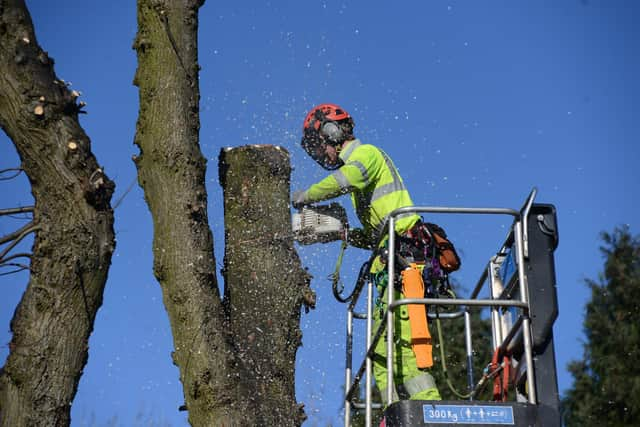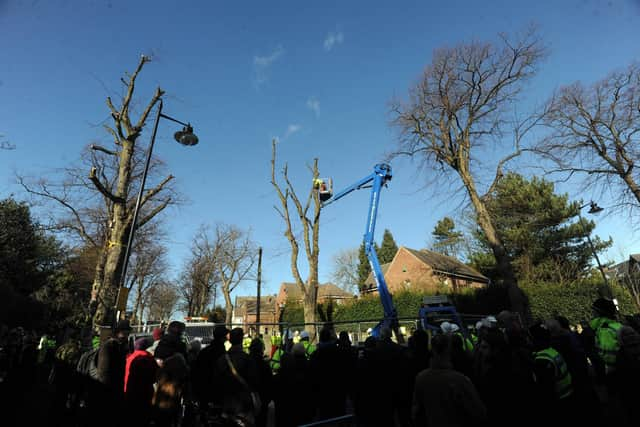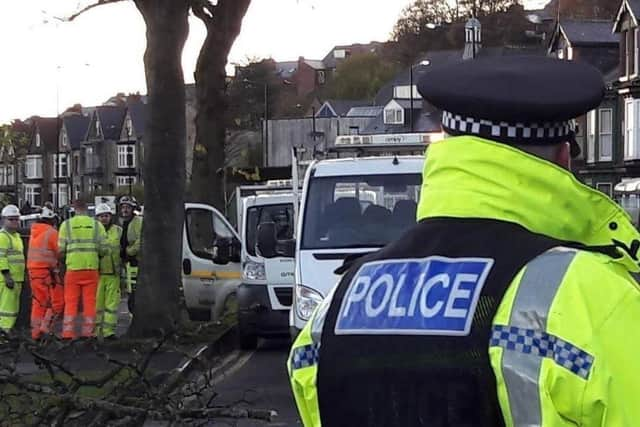How campaigners saved 11,000 Sheffield trees from the axe after council tried to jail them
In an extraordinary 2,000-word mea culpa the council’s new leader, Tom Hunt, and chief executive, Kate Josephs, made a grovelling apology for actions and “misleading” statements made by officials. The apology, which was four pages long, acknowledged that the council had “failed to communicate in an open and honest way” and stated: “We recognise that this full apology, for some, is a long time coming, and we understand that due to the council’s behaviour, some people will never forgive Sheffield city council and have lost trust and faith in us. “
From going back over the facts, however, it’s clear the council had little choice but to finally hold up its hands after over more than a decade of denials.
Advertisement
Hide AdAdvertisement
Hide AdIn 2012 Sheffield council and the civil engineering firm Amey struck a £2 billion deal to improve the city’s crumbling roads and pavements. It contained one extraordinary secret clause: a contractual target to remove half the city’s street trees, added as a consequence of a misreading of a consultant’s report. Instead of the 1,000 trees that needed to be replaced with saplings, the contract erroneously stipulated 17,500 had to go.


Council bosses initially saw the figure as a positive, partly because they thought it would reduce frequent complaints about ‘nuisance’ trees. But when the felling programme became increasingly controversial, council officials started claiming in public that not only was there no target, but any trees being taken down were only removed as a “last resort” after all other options had been exhausted.
As the felling work progressed, disparate residents unhappy about what was happening in their particular areas started coming together to form community groups. Save Our Roadside Trees whose leaders included PR professional Louise Wilcockson, vet Dr Deepa Shetta and arboriculturist David Long began bringing the issue to wider media attention in 2015, organising petitions, protests and even Christmas celebrations under threatened trees.
Campaigners eventually formed an umbrella organisation called the Sheffield Trees Action Groups (STAG), founded by former actor Dave Dillner who had first started campaigning in 2014 after hearing of plans to cut down 188 trees in his local area to create a new bus lane.
Advertisement
Hide AdAdvertisement
Hide AdMy original interest in the story was in trying to understand the motivations of the people who had put their ordinary lives on hold to campaign against the felling. Those like Helen McIlroy, a former teacher who camped out for a month near the threatened lime trees on Rustlings Road, which were eventually chopped down in a now-infamous dawn raid.


As well as putting their liberty and limbs on the line by standing under threatened trees, campaigners turned amateur detective to unpick the web of deceit the council was spinning about the issue. Carefully targeted freedom of information (FoI) requests gradually exposed the gaping mismatches between the council’s public statements and what was really going on.
In March 2018, as the dispute was reaching its height, a year-long FoI campaign by Paul Selby, a Sheffield-based civil servant for the Department for Work and Pensions, produced the “smoking gun” evidence campaigners had long believed existed. The information commissioner ordered the council to publish previously redacted parts of the contract, which included a key passage stating at least 200 trees a year needed to be replaced “so that 17,500 trees are replaced by the end of the term”.
Despite the evidence, the council continued to deny the figure was a target and instead described it as “insurance”. As well as the street protests and the FoI battles, the bitter dispute increasingly played out in the courts. After securing an injunction that effectively prevented protests directly underneath threatened trees, the council started legal proceedings to commit those deemed to have breached it to prison. Among those targeted by the Labour-led administration was a Green Party councillor, Alison Teal, who had opposed the felling. The case against her was dismissed.
Advertisement
Hide AdAdvertisement
Hide AdThe council spent more than £400,000 of public money on legal proceedings against campaigners.


In the meantime - encouraged and supported by my editor James Mitchinson - I was working on exposing the extent of the scandal.
One story I was particularly proud of came after the council had won the injunction and given a press conference in which Councillor Bryan Lodge made the eyebrow-raising claim that the authority would face “catastrophic financial consequences” if felling was not completed by the end of the year. By reading the public parts of the lengthy Amey contract, I was able to prove that the council was not in fact liable for any extra costs.
The paper took a strong editorial line against both the felling and the secrecy surrounding it - but instead of the legitimate concerns being addressed, we were accused of pursuing a spiteful agenda of fake news. When then Environment Secretary Michael Gove cited the paper’s “persistent and persuasive” reporting as he called on the council to halt the work, cabinet member Bryan Lodge issued an extraordinary response claiming that Mr Gove had fallen victim to “misinformation” and even added that stopping the felling would be “morally reprehensible”.
Advertisement
Hide AdAdvertisement
Hide AdAs the dispute reached its height in early 2018, dozens of private security guards and police officers were dispatched daily to support felling operations. A total of 41 arrests were made over the course of the dispute (including one for the “crime” of blowing a toy horn) and one successful prosecution. I’ll never forget witnessing 30-plus officers pouring out of vans on one leafy city street so that a couple of trees could be chopped down. Whatever your views on the felling programme — and there were plenty in Sheffield who thought it a good idea — it was hard for anyone to deny the scale of public policy failure necessary to reach that point.
By the time the felling was stopped in March 2018, about 6,000 trees had gone, but the collective actions of the campaigners ultimately saved more than 11,000 trees from the axe — one of the most successful environmental protests of all time. In the intervening years South Yorkshire police has had to pay out £24,300 to seven campaigners who were wrongfully detained while protesting to save the trees. Council leaders however, spent years denying that they had misled anyone and might well have been saying the same thing today were it not for the damning findings of an official inquiry by Sir Mark Lowcock, published in March.
Lowcock said it was clear there was a contractual target and, had there been no campaign to stop it, “the programme would now be on track to replace 17,500 trees”. He also said the council had twice misled the courts by telling judges its strategy prioritised saving trees where possible.
The report also revealed more about the extraordinary loss of perspective within Sheffield council as the dispute played out. The authority commissioned a barrister to outline what legal action it could take against South Yorkshire police to force them to arrest more protesters. Paul Billington, then the council’s “director of place”, even suggested internally to Lodge and John Mothersole, then the chief executive, that healthy trees could be maimed with a technique called ring-barking to move them into the “dying” category. Lowcock said: “Some of the things the council did were unacceptable. Some of the ideas it flirted with but did not pursue were worse.”
Advertisement
Hide AdAdvertisement
Hide AdThe council’s apology letter said: “Protesters and campaigners were maligned, injured and experienced physical, emotional, and for some, financial stress. The action the Council took damaged Sheffield’s reputation in a way that casts a long shadow.”
Though much of this seems incredible now, more tree-felling scandals have since emerged in Plymouth and elsewhere. But what the Sheffield story is ultimately about is the abuse of democratic power — and the importance of listening to local people brave enough to challenge it.
A version of this article first appeared in the Sunday Times.